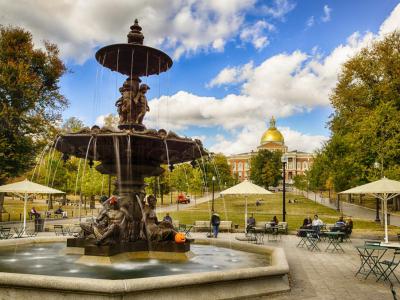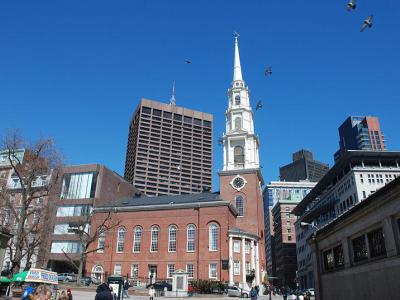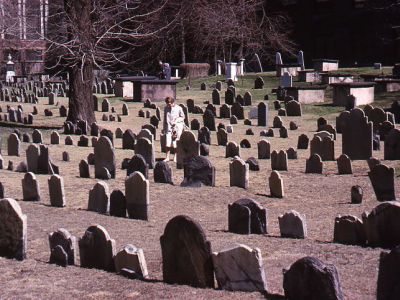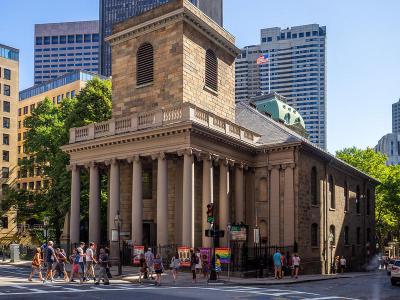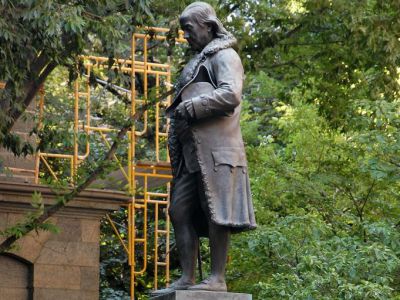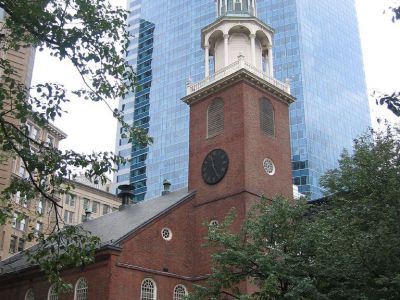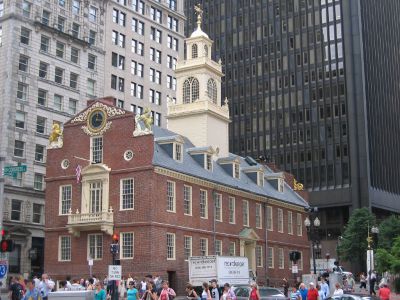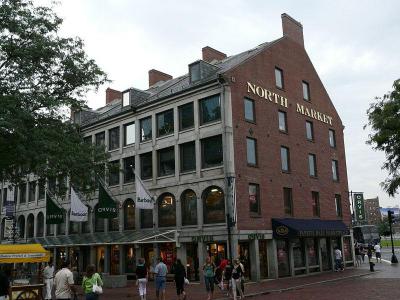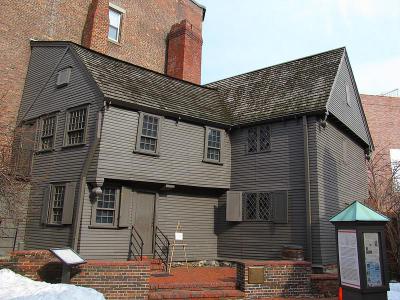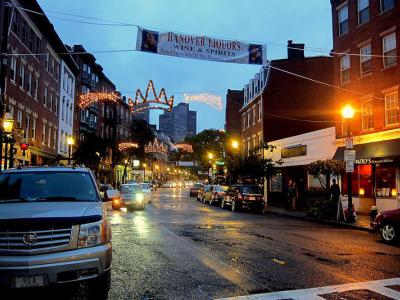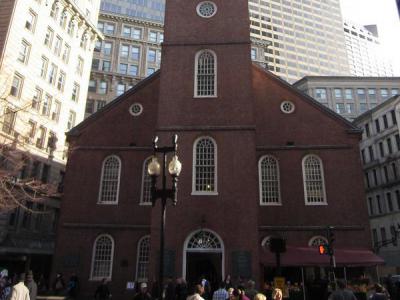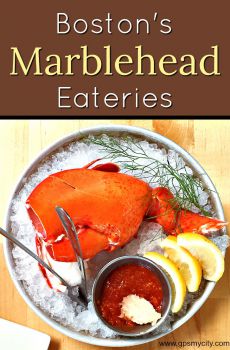Audio Guide: Boston Introduction Walking Tour (Self Guided), Boston
The capital of the Commonwealth of Massachusetts, Boston is one of the oldest cities in the United States and it had played a key role in the country's struggle for independence. Founded in 1630 by Puritan settlers from England, it witnessed many events of the American Revolution, including the Boston Massacre, the Boston Tea Party, the Battle of Bunker Hill, and the Siege of Boston.
Before European colonization, the territory was inhabited by an indigenous tribe called Massachusett. Early European settlers had first called the area Trimountaine after its three mountains, only traces of which remain today. The city was later renamed after Boston, Lincolnshire, England, where several prominent colonists had originated from.
Boston has been a noted religious center since its earliest days. King's Chapel was the city's first Anglican church, founded in 1686. Other prominent local temples include Christ Church built in 1723 and better known as Old North Church, Park Street Church built in 1810, and many others.
Before the mid-18th century, the city had been the largest in the Thirteen Colonies and was home to many of America's firsts, such as the first public park (Boston Common in 1634), the first public school (Boston Latin School in 1635), the first subway system (Tremont Street subway in 1897), as well as numerous historical attractions, like the Faneuil Hall Marketplace.
Boston's oceanfront location made it a lively port, and the city primarily engaged in shipping and fishing during its colonial days. After the American Revolution, Boston's long seafaring tradition helped to make it one of the nation's busiest ports. It also thrived as a manufacturing hub.
In the 1800s, the local population grew rapidly amid the first wave of European immigrants, dominated by the Irish who fled the Great Famine back home. It established itself as the transportation hub for the New England region with its network of railroads, and even more importantly, the intellectual and educational center of the nation.
More immigrants came in the latter half of the 19th century. Chief among them were Germans, Lebanese, Syrians, French Canadians, and Russian and Polish Jewish settlers. The city's industrial base continued to expand well into the 20th century. In the 21st century, the city's economy is centered on education, medicine, financials, and high technology.
Nowadays, Boston's rich heritage lures history buffs and tourists in great numbers. Visitors from around the world come to see historical places like Paul Revere House and Old North Church, and learn the history of American Independence.
If you wish to follow in the footsteps of Boston's heroes, see memorials to the world-changing events, and generally make the most of your time in Boston, take this self-guided introduction walk to explore some of the city's most prominent sights!
Before European colonization, the territory was inhabited by an indigenous tribe called Massachusett. Early European settlers had first called the area Trimountaine after its three mountains, only traces of which remain today. The city was later renamed after Boston, Lincolnshire, England, where several prominent colonists had originated from.
Boston has been a noted religious center since its earliest days. King's Chapel was the city's first Anglican church, founded in 1686. Other prominent local temples include Christ Church built in 1723 and better known as Old North Church, Park Street Church built in 1810, and many others.
Before the mid-18th century, the city had been the largest in the Thirteen Colonies and was home to many of America's firsts, such as the first public park (Boston Common in 1634), the first public school (Boston Latin School in 1635), the first subway system (Tremont Street subway in 1897), as well as numerous historical attractions, like the Faneuil Hall Marketplace.
Boston's oceanfront location made it a lively port, and the city primarily engaged in shipping and fishing during its colonial days. After the American Revolution, Boston's long seafaring tradition helped to make it one of the nation's busiest ports. It also thrived as a manufacturing hub.
In the 1800s, the local population grew rapidly amid the first wave of European immigrants, dominated by the Irish who fled the Great Famine back home. It established itself as the transportation hub for the New England region with its network of railroads, and even more importantly, the intellectual and educational center of the nation.
More immigrants came in the latter half of the 19th century. Chief among them were Germans, Lebanese, Syrians, French Canadians, and Russian and Polish Jewish settlers. The city's industrial base continued to expand well into the 20th century. In the 21st century, the city's economy is centered on education, medicine, financials, and high technology.
Nowadays, Boston's rich heritage lures history buffs and tourists in great numbers. Visitors from around the world come to see historical places like Paul Revere House and Old North Church, and learn the history of American Independence.
If you wish to follow in the footsteps of Boston's heroes, see memorials to the world-changing events, and generally make the most of your time in Boston, take this self-guided introduction walk to explore some of the city's most prominent sights!
How it works: Download the app "GPSmyCity: Walks in 1K+ Cities" from Apple App Store or Google Play Store to your mobile phone or tablet. The app turns your mobile device into a personal tour guide and its built-in GPS navigation functions guide you from one tour stop to next. The app works offline, so no data plan is needed when traveling abroad.
Boston Introduction Walking Tour Map
Guide Name: Boston Introduction Walking Tour
Guide Location: USA » Boston (See other walking tours in Boston)
Guide Type: Self-guided Walking Tour (Sightseeing)
# of Attractions: 11
Tour Duration: 2 Hour(s)
Travel Distance: 2.3 Km or 1.4 Miles
Author: anna
Sight(s) Featured in This Guide:
Guide Location: USA » Boston (See other walking tours in Boston)
Guide Type: Self-guided Walking Tour (Sightseeing)
# of Attractions: 11
Tour Duration: 2 Hour(s)
Travel Distance: 2.3 Km or 1.4 Miles
Author: anna
Sight(s) Featured in This Guide:
- Boston Common
- Park Street Church
- Granary Burying Ground
- King's Chapel and Burying Ground
- Benjamin Franklin Statue
- Old South Meeting House
- Old State House
- Faneuil Hall Marketplace
- Paul Revere House
- Hanover Street
- Old North Church
1) Boston Common (must see)
Boston Common, the city's primary open space, spans fifty acres of greenery, effectively serving as a buffer between the historic and bustling Downtown area and its upscale neighbors, Beacon Hill and Back Bay. While it may not have the meticulous landscaping of the nearby Public Garden, it still offers an abundance of benches and open lawns for relaxing breaks, and it frequently transforms into a venue for concerts, events, and public gatherings.
Before John Winthrop and his fellow Puritan settlers designated Boston Common for public use, it served as pastureland for the Reverend William Braxton. Blaxton was a priest of the Church of England. In 1623, as chaplain to the Ferdinando Gorges expedition, he sailed on the ship Katherine to the settlement of Weymouth, Massachusetts. The expedition failed, and everyone returned to England in 1625. But Blaxton stayed and became the first European to settle in Boston.
Puritans from Charlestown joined Blaxton in 1630 and awarded him fifty acres. He cannily sold it back to them in 1634, and this land became known as Boston Common, the oldest city park in the United States. Soon after, it took on darker associations, functioning as a site for hangings, including those of alleged pirates, witches, and various religious dissenters. An unfortunate commoner by the name of Rachell Whall met her end here for the theft of a bonnet valued at 75¢.
In 1789, newly elected President George Washington made a memorable appearance on the Common. Over the years, renowned figures like Martin Luther King, Jr., Pope John Paul II, and Mikhail Gorbachev have delivered speeches on its grounds, while Judy Garland enthralled more than 100,000 fans with her performance here in 1967. The history of this place also extends far into the past, with prehistoric Native American sites dating back up to 8,500 years found within its boundaries.
Around the park, there are several noteworthy sites to explore, including Brewer Fountain Plaza, the Boston Common Visitor Information Center, the Soldiers and Sailors Monument, the Frog Pond, the Central Burying Ground, and the recently restored Robert Gould Shaw 54th Regiment Memorial.
Before John Winthrop and his fellow Puritan settlers designated Boston Common for public use, it served as pastureland for the Reverend William Braxton. Blaxton was a priest of the Church of England. In 1623, as chaplain to the Ferdinando Gorges expedition, he sailed on the ship Katherine to the settlement of Weymouth, Massachusetts. The expedition failed, and everyone returned to England in 1625. But Blaxton stayed and became the first European to settle in Boston.
Puritans from Charlestown joined Blaxton in 1630 and awarded him fifty acres. He cannily sold it back to them in 1634, and this land became known as Boston Common, the oldest city park in the United States. Soon after, it took on darker associations, functioning as a site for hangings, including those of alleged pirates, witches, and various religious dissenters. An unfortunate commoner by the name of Rachell Whall met her end here for the theft of a bonnet valued at 75¢.
In 1789, newly elected President George Washington made a memorable appearance on the Common. Over the years, renowned figures like Martin Luther King, Jr., Pope John Paul II, and Mikhail Gorbachev have delivered speeches on its grounds, while Judy Garland enthralled more than 100,000 fans with her performance here in 1967. The history of this place also extends far into the past, with prehistoric Native American sites dating back up to 8,500 years found within its boundaries.
Around the park, there are several noteworthy sites to explore, including Brewer Fountain Plaza, the Boston Common Visitor Information Center, the Soldiers and Sailors Monument, the Frog Pond, the Central Burying Ground, and the recently restored Robert Gould Shaw 54th Regiment Memorial.
2) Park Street Church
Resembling an enlarged version of a typical New England village church, the Park Street Church has stood at the junction of Park and Tremont streets, directly across from Boston Common, since its consecration in 1810. Designed by English architect Peter Banner, who adapted a design by Christopher Wren, one of history's most celebrated English architects, it continues to be one of the city's most influential pulpits. While the building itself is rather unassuming, constructed primarily of bricks and mortar, its striking 217-foot-tall white telescoping steeple commands undeniable attention.
However, the church's renown is not solely based on its physical stature but also on the significant events that unfolded within its walls. In 1819, the parish dispatched the nation's first missionaries to Hawaii. A decade later, on July 4, 1829, William Lloyd Garrison, a prominent journalist and social reformer, delivered his first public address, advocating for the nationwide abolition of slavery. Then, on July 4, 1831, the classic patriotic song "America" ("My country, 'tis of thee...") resounded through the church rafters for the first time.
Contrary to popular belief, the intersection did not earn the moniker "Brimstone Corner" due to the church's sermons. Instead, the name harks back to the War of 1812 when the US militia stored its gunpowder in the church's basement for safekeeping against potential bombardment by the British Navy.
Park Street itself inclines upward along the perimeter of Boston Common toward the Old State House. In the past, this thoroughfare was recognized as Bulfinch Row, named after the architect Charles Bulfinch, owing to the numerous brick townhouses he designed along it. Today, only one of these remains, the imposing bay-windowed townhouse at #9. Constructed in 1804 for George Ticknor, the initial publisher of the Atlantic Monthly, it presently serves as the location for the esteemed French and Italian restaurant No. 9 Park.
However, the church's renown is not solely based on its physical stature but also on the significant events that unfolded within its walls. In 1819, the parish dispatched the nation's first missionaries to Hawaii. A decade later, on July 4, 1829, William Lloyd Garrison, a prominent journalist and social reformer, delivered his first public address, advocating for the nationwide abolition of slavery. Then, on July 4, 1831, the classic patriotic song "America" ("My country, 'tis of thee...") resounded through the church rafters for the first time.
Contrary to popular belief, the intersection did not earn the moniker "Brimstone Corner" due to the church's sermons. Instead, the name harks back to the War of 1812 when the US militia stored its gunpowder in the church's basement for safekeeping against potential bombardment by the British Navy.
Park Street itself inclines upward along the perimeter of Boston Common toward the Old State House. In the past, this thoroughfare was recognized as Bulfinch Row, named after the architect Charles Bulfinch, owing to the numerous brick townhouses he designed along it. Today, only one of these remains, the imposing bay-windowed townhouse at #9. Constructed in 1804 for George Ticknor, the initial publisher of the Atlantic Monthly, it presently serves as the location for the esteemed French and Italian restaurant No. 9 Park.
3) Granary Burying Ground
Adjacent to Park Street Church, you'll find one of the more serene destinations in Boston -the historic Old Granary Burying Ground. Serving as the final resting place for numerous leaders of the American Revolution, its entrance features an Egyptian Revival arch facing Tremont Street, and it is from Tremont's sidewalk that you can best appreciate some of the most famous gravesites.
On the side closest to Park Street Church, there is a boulder with an attached plaque marking the tomb of the revolutionary figure James Otis, known for his eloquent speeches against British tyranny. A few tombs down, heading away from the church, you'll find the resting place of Samuel Adams, the charismatic patriot whose involvement in beer brewing has made him a household name. Next to his tomb is the communal grave of the five individuals killed in the Boston Massacre of 1770, an event that intensified anti-Tory sentiment in Boston.
From any vantage point within the cemetery, you can spot the robust obelisk at its center, which marks the grave of Benjamin Franklin's parents. Wealthier families often chose more secure burial vaults and table tombs, such as semi-submerged sarcophagi. Peter Faneuil, the benefactor of Boston's most prominent meeting hall, rests in one of the latter, situated in the left rear corner of the burial ground.
Midway along the path at the back is the grave of the renowned messenger and silversmith Paul Revere. Across from Revere, in a red-toned sarcophagus, you'll find the infamous Salem Witch Trial Judge, Samuel Sewall, who later expressed remorse for his role in the "condemnation" of "innocent people". On the Park Street Church side, opposite the judge's grave, a white pillar designates the final resting place of John Hancock, a signer of the Declaration of Independence. Another signatory, Robert Paine, lies along the eastern edge.
On the side closest to Park Street Church, there is a boulder with an attached plaque marking the tomb of the revolutionary figure James Otis, known for his eloquent speeches against British tyranny. A few tombs down, heading away from the church, you'll find the resting place of Samuel Adams, the charismatic patriot whose involvement in beer brewing has made him a household name. Next to his tomb is the communal grave of the five individuals killed in the Boston Massacre of 1770, an event that intensified anti-Tory sentiment in Boston.
From any vantage point within the cemetery, you can spot the robust obelisk at its center, which marks the grave of Benjamin Franklin's parents. Wealthier families often chose more secure burial vaults and table tombs, such as semi-submerged sarcophagi. Peter Faneuil, the benefactor of Boston's most prominent meeting hall, rests in one of the latter, situated in the left rear corner of the burial ground.
Midway along the path at the back is the grave of the renowned messenger and silversmith Paul Revere. Across from Revere, in a red-toned sarcophagus, you'll find the infamous Salem Witch Trial Judge, Samuel Sewall, who later expressed remorse for his role in the "condemnation" of "innocent people". On the Park Street Church side, opposite the judge's grave, a white pillar designates the final resting place of John Hancock, a signer of the Declaration of Independence. Another signatory, Robert Paine, lies along the eastern edge.
4) King's Chapel and Burying Ground
Originally, an Anglican wooden chapel, the first of its kind in New England, was constructed on this site in 1688. Later, when the governor of New England deemed a larger church necessary, the current structure, which was initiated in 1749, was built around the original chapel. Following the American Revolution, the congregation shifted from Anglican to Unitarian. Inside the sanctuary, you can find a raised pulpit dating back to 1717, one of the oldest in the United States. Another standout feature is the chapel's bell, the largest ever cast by the Revere foundry and the last one personally cast by Paul Revere himself to replace the original one that had cracked.
The main attraction, though, is the atmospheric King's Chapel Burying Ground, Boston's oldest cemetery, often overlooked by busy passersby. Within it, there are many beautifully etched gravestones adorned with winged skulls and contemplative seraphim. One of the finest examples belongs to an unknown Joseph Tapping near the Tremont Street side. Among the prominent Bostonians interred here are John Winthrop, the first governor of Massachusetts, and Mary Chilton, the first Pilgrim to land on Plymouth Rock. At the center of the burial site is the tomb of William Dawes, the lesser-known patriot who joined Paul Revere on his renowned "midnight ride" to Lexington.
King's Chapel Burying Ground was a favored spot for author Nathaniel Hawthorne, who frequented the grave of Elizabeth Pain, the inspiration for the infamous adulterous character Hester Prynne in his novel "The Scarlet Letter".
The main attraction, though, is the atmospheric King's Chapel Burying Ground, Boston's oldest cemetery, often overlooked by busy passersby. Within it, there are many beautifully etched gravestones adorned with winged skulls and contemplative seraphim. One of the finest examples belongs to an unknown Joseph Tapping near the Tremont Street side. Among the prominent Bostonians interred here are John Winthrop, the first governor of Massachusetts, and Mary Chilton, the first Pilgrim to land on Plymouth Rock. At the center of the burial site is the tomb of William Dawes, the lesser-known patriot who joined Paul Revere on his renowned "midnight ride" to Lexington.
King's Chapel Burying Ground was a favored spot for author Nathaniel Hawthorne, who frequented the grave of Elizabeth Pain, the inspiration for the infamous adulterous character Hester Prynne in his novel "The Scarlet Letter".
5) Benjamin Franklin Statue
In front of the old City Hall, on the site where the original Boston Latin School once stood, you'll discover the 8-foot bronze statue of Benjamin Franklin. Created by local sculptor Richard Greenough and installed in 1856, it was notably the first statue of a human to be placed in any city in America. It's worth noting that while many people think of Benjamin Franklin as a U.S. president, he was, in fact, one of the Founding Fathers, a statesman, and a diplomat, but he never served as President of the United States.
Born in Boston in 1706, Franklin attended the Boston Latin School as a young boy; however, he did not complete his formal education and instead began working for his brother, who owned a printing press. Franklin eventually started publishing his own articles and ventured into politics, where he advocated passionately for the abolition of slavery and the protection of Native American rights. He holds the unique distinction of being the only person to have signed all four of the most significant documents in American history: the Declaration of Independence, the Alliance with France Treaty, the Peace with Great Britain Treaty, and the Constitution of the United States.
In addition to his political career, Benjamin Franklin was a renowned scientist and inventor. In 1749, he invented the lightning rod. He also played a significant role in establishing the first public lending library and the first fire department in Pennsylvania.
Tips:
For better lighting when photographing the statue, consider visiting in the morning – though you can still capture a decent photo in the afternoon. If you're a meat lover, Ruth's Chris Steak House is located nearby, making it a good dining option.
Born in Boston in 1706, Franklin attended the Boston Latin School as a young boy; however, he did not complete his formal education and instead began working for his brother, who owned a printing press. Franklin eventually started publishing his own articles and ventured into politics, where he advocated passionately for the abolition of slavery and the protection of Native American rights. He holds the unique distinction of being the only person to have signed all four of the most significant documents in American history: the Declaration of Independence, the Alliance with France Treaty, the Peace with Great Britain Treaty, and the Constitution of the United States.
In addition to his political career, Benjamin Franklin was a renowned scientist and inventor. In 1749, he invented the lightning rod. He also played a significant role in establishing the first public lending library and the first fire department in Pennsylvania.
Tips:
For better lighting when photographing the statue, consider visiting in the morning – though you can still capture a decent photo in the afternoon. If you're a meat lover, Ruth's Chris Steak House is located nearby, making it a good dining option.
6) Old South Meeting House
The Old South Meeting House is known for its simple, unadorned design, which stood in contrast to the more ornate architecture of Anglican churches of the time. Built in 1729, it was the largest meeting place in colonial Boston and played a significant role in the events leading up to the American Revolution. The large interior hall served as a gathering place for town meetings, and it gained fame for hosting fervent speeches by the Sons of Liberty, a group of American patriots who protested British taxation and other grievances.
One of the most notable events that took place at the Old South Meeting House occurred on December 16, 1773, during a candlelit protest rally against the British Tea Act. Samuel Adams, a prominent figure in the American Revolution, delivered a speech at the meeting house and flashed a signal that led to the Boston Tea Party later that night when colonists, disguised as Native Americans, boarded British ships and dumped tea into Boston Harbor as a protest against British taxation without representation. In retaliation, the British occupied the Old South Meeting House, using it as an officers' tavern and stable.
Fortunately, the building was saved from destruction and eventually became a museum in 1877. Today, it offers a series of lectures covering various New England topics and hosts chamber music concerts and other musical performances. The museum shop features a wide range of merchandise, including "Boston Tea Party" tea.
Across Washington Street from the Old South Meeting House, you can find a memorial to the Irish Potato Famine of 1845-1849, created by sculptor Robert Shure and added to the square in 1998.
One of the most notable events that took place at the Old South Meeting House occurred on December 16, 1773, during a candlelit protest rally against the British Tea Act. Samuel Adams, a prominent figure in the American Revolution, delivered a speech at the meeting house and flashed a signal that led to the Boston Tea Party later that night when colonists, disguised as Native Americans, boarded British ships and dumped tea into Boston Harbor as a protest against British taxation without representation. In retaliation, the British occupied the Old South Meeting House, using it as an officers' tavern and stable.
Fortunately, the building was saved from destruction and eventually became a museum in 1877. Today, it offers a series of lectures covering various New England topics and hosts chamber music concerts and other musical performances. The museum shop features a wide range of merchandise, including "Boston Tea Party" tea.
Across Washington Street from the Old South Meeting House, you can find a memorial to the Irish Potato Famine of 1845-1849, created by sculptor Robert Shure and added to the square in 1998.
7) Old State House (must see)
As the oldest surviving public building in Boston, this colonial-era landmark has one of the most easily recognizable facades in the city. Its gable is adorned with a brightly gilded lion and silver unicorn, symbols representing British imperial power. From 1713 until the Revolutionary period, this structure served as the seat of colonial government. After the British evacuated Boston in 1776, it continued to function as the center of the independent Commonwealth until its replacement on Beacon Hill was constructed.
An impassioned speech delivered by James Otis in the Council Chamber on the second floor ignited the pursuit of independence from Britain. Otis, initially a Crown appointee who later aligned with the colonial cause, vehemently opposed the Writs of Assistance, which granted the British the authority to inspect private property without restriction. Legend has it that, on certain nights, one can still hear echoes of his anti-British rhetoric, accompanied by the enthusiastic cheers of the crowd he galvanized.
The balcony overlooking State Street is as renowned as Otis's speech, as it was from here on July 18, 1776, that the Declaration of Independence was first publicly read in Boston, just after its arrival from Philadelphia. That very night, the lion and unicorn figures symbolizing British rule, which were mounted above the balcony, were torn down and burned in front of the Bunch of Grapes tavern; the current ones on display are replicas. In a gesture of goodwill, Queen Elizabeth II, the first British monarch to visit Boston since the Revolution, delivered a speech from the balcony during the American bicentennial celebrations in 1976.
Today, the site hosts a small yet comprehensive museum. The ground-level permanent exhibit, titled "Colony to Commonwealth", features a series of well-curated displays that chronicle Boston's pivotal role in inciting the Revolutionary War. Among the exhibits are remnants from Boston's infamous tea party, the royal arms plaque that once adorned Province House (the official residence of colonial governors), the flag used by the Sons of Liberty to announce their gatherings, a stylish jacket owned by (Founding Father) John Hancock, and Paul Revere's stirring engraving of the Boston Massacre, one of the most evocative images of the Revolutionary era. Additionally, every half-hour, a colonial "guest speaker" in character provides insights into early Boston life and answers questions for the audience.
An impassioned speech delivered by James Otis in the Council Chamber on the second floor ignited the pursuit of independence from Britain. Otis, initially a Crown appointee who later aligned with the colonial cause, vehemently opposed the Writs of Assistance, which granted the British the authority to inspect private property without restriction. Legend has it that, on certain nights, one can still hear echoes of his anti-British rhetoric, accompanied by the enthusiastic cheers of the crowd he galvanized.
The balcony overlooking State Street is as renowned as Otis's speech, as it was from here on July 18, 1776, that the Declaration of Independence was first publicly read in Boston, just after its arrival from Philadelphia. That very night, the lion and unicorn figures symbolizing British rule, which were mounted above the balcony, were torn down and burned in front of the Bunch of Grapes tavern; the current ones on display are replicas. In a gesture of goodwill, Queen Elizabeth II, the first British monarch to visit Boston since the Revolution, delivered a speech from the balcony during the American bicentennial celebrations in 1976.
Today, the site hosts a small yet comprehensive museum. The ground-level permanent exhibit, titled "Colony to Commonwealth", features a series of well-curated displays that chronicle Boston's pivotal role in inciting the Revolutionary War. Among the exhibits are remnants from Boston's infamous tea party, the royal arms plaque that once adorned Province House (the official residence of colonial governors), the flag used by the Sons of Liberty to announce their gatherings, a stylish jacket owned by (Founding Father) John Hancock, and Paul Revere's stirring engraving of the Boston Massacre, one of the most evocative images of the Revolutionary era. Additionally, every half-hour, a colonial "guest speaker" in character provides insights into early Boston life and answers questions for the audience.
8) Faneuil Hall Marketplace (must see)
Faneuil Hall Marketplace, situated in a pedestrian zone east of Government Center, is a vibrant public gathering spot that appeals to both tourists and, to a lesser extent, locals. It's an excellent place to enjoy a meal, soak in a bit of history, and take advantage of free Wi-Fi access. Originally constructed during colonial times as a marketplace to accommodate the city's burgeoning mercantile industry, it saw a decline in the 19th century and, like the surrounding area, remained relatively inactive until the 1960s. At that point, it was successfully revitalized as a restaurant and shopping complex.
The much-talked-about Faneuil Hall itself might not appear particularly imposing from the outside. It's a modest four-story brick building crowned with a golden grasshopper weathervane-certainly not the grand auditorium that one might envision as the birthplace of Revolutionary War meetings, earning it the moniker "Cradle of Liberty". In its earlier days, the first floor housed an open-air market, while the second floor served as a space for political gatherings. This is where fiery revolutionaries like Samuel Adams and James Otis rallied popular support for independence by protesting British tax policies.
Today, the first floor houses an array of tourist-centric shops and an info-desk, but the second is more impressive, with the auditorium preserved to reflect the alterations made by Charles Bulfinch in 1805. Its centerpiece is a flamboyant (albeit somewhat exaggerated) canvas depicting "The Great Debate", during which Daniel Webster argued for the concept of the United States as one nation against South Carolina Senator Robert Hayne. While the debate indeed took place, the painting includes several 19th-century figures like Nathaniel Hawthorne and Alexis de Tocqueville, who were not actually present-the artist added them to boost the painting's appeal.
A more grounded story relates to how Boston sailors secured free passage back home from Britain during the War of 1812: captive Boston sailors who escaped to the American consulate were asked what adorned Faneuil Hall as a weathervane. Those who correctly identified it as a grasshopper were considered true Bostonians and given a free journey back, while those who couldn't were eyed with suspicion.
On the top floor, the Ancient & Honorable Artillery Co of Massachusetts, established in 1638, curates a peculiar collection of antique firearms, political memorabilia, and curious artifacts.
The much-talked-about Faneuil Hall itself might not appear particularly imposing from the outside. It's a modest four-story brick building crowned with a golden grasshopper weathervane-certainly not the grand auditorium that one might envision as the birthplace of Revolutionary War meetings, earning it the moniker "Cradle of Liberty". In its earlier days, the first floor housed an open-air market, while the second floor served as a space for political gatherings. This is where fiery revolutionaries like Samuel Adams and James Otis rallied popular support for independence by protesting British tax policies.
Today, the first floor houses an array of tourist-centric shops and an info-desk, but the second is more impressive, with the auditorium preserved to reflect the alterations made by Charles Bulfinch in 1805. Its centerpiece is a flamboyant (albeit somewhat exaggerated) canvas depicting "The Great Debate", during which Daniel Webster argued for the concept of the United States as one nation against South Carolina Senator Robert Hayne. While the debate indeed took place, the painting includes several 19th-century figures like Nathaniel Hawthorne and Alexis de Tocqueville, who were not actually present-the artist added them to boost the painting's appeal.
A more grounded story relates to how Boston sailors secured free passage back home from Britain during the War of 1812: captive Boston sailors who escaped to the American consulate were asked what adorned Faneuil Hall as a weathervane. Those who correctly identified it as a grasshopper were considered true Bostonians and given a free journey back, while those who couldn't were eyed with suspicion.
On the top floor, the Ancient & Honorable Artillery Co of Massachusetts, established in 1638, curates a peculiar collection of antique firearms, political memorabilia, and curious artifacts.
9) Paul Revere House (must see)
A small triangular enclave adorned with cobblestones and gaslights, North Square stands out as one of Boston's most historically significant and aesthetically appealing corners. Here, eateries take a back seat to the Paul Revere House, which holds the distinction of being downtown Boston's oldest residential address, located at 19 North Square. Paul Revere, a lifelong North Ender, called this place home from 1770 to 1800, with the exception of much of 1775 when he was in hiding from the British in Watertown.
Originally built around 1680, the small Tudor-style structure, constructed with post-and-beam framing, underwent various uses over the years, including stints as a grocery store, tenement, and cigar factory. In 1908, it was painstakingly restored to its 17th-century appearance (remarkably, 90% of the framework is original). The house stands on the site where the grander residence of Puritan leader Increase Mather (father of Cotton Mather) once stood before it was destroyed in the Great Fire of 1676.
While the building's significance lies more in its historical longevity than its architectural grandeur, its third-floor Elizabethan-style overhang and leaded windowpanes provide a nice contrast to the surrounding red-brick buildings. Upstairs, you can explore examples of Revere's handcrafted silverware, worth a look for their craftsmanship and historical value. The museum also hosts a series of compact yet thought-provoking rotating exhibitions, shedding light on subjects such as the mythologizing of Revere's famous horseback ride.
Throughout the year, special events are organized, many of which are family-friendly. These events often feature period-costumed characters engaging in role-play, serving colonial-era treats like apple-cider cake, showcasing a silversmith practicing his craft, entertaining crowds with dulcimer music, or staging military reenactments in authentic period attire.
Originally built around 1680, the small Tudor-style structure, constructed with post-and-beam framing, underwent various uses over the years, including stints as a grocery store, tenement, and cigar factory. In 1908, it was painstakingly restored to its 17th-century appearance (remarkably, 90% of the framework is original). The house stands on the site where the grander residence of Puritan leader Increase Mather (father of Cotton Mather) once stood before it was destroyed in the Great Fire of 1676.
While the building's significance lies more in its historical longevity than its architectural grandeur, its third-floor Elizabethan-style overhang and leaded windowpanes provide a nice contrast to the surrounding red-brick buildings. Upstairs, you can explore examples of Revere's handcrafted silverware, worth a look for their craftsmanship and historical value. The museum also hosts a series of compact yet thought-provoking rotating exhibitions, shedding light on subjects such as the mythologizing of Revere's famous horseback ride.
Throughout the year, special events are organized, many of which are family-friendly. These events often feature period-costumed characters engaging in role-play, serving colonial-era treats like apple-cider cake, showcasing a silversmith practicing his craft, entertaining crowds with dulcimer music, or staging military reenactments in authentic period attire.
10) Hanover Street
Hanover Street, alongside Salem Street, forms the vibrant Italian core of Boston's North End. While you may still hear traces of Italian spoken by the older generation, many of the Italian-American families that once resided here in the early 20th century have since relocated to the suburbs. Nevertheless, their legacy endures in the form of cafes, restaurants, bakeries, bars, and even a private cigar-smoking club that continue to thrive.
Hanover Street’s narrowness makes it best explored on foot, ideally at a leisurely pace with ample opportunities to savor the ambiance. In the evening, it comes alive with both locals and visitors seeking delicious meals. Saint Stephen's Catholic Church, often regarded as the home parish of Rose Fitzgerald Kennedy, the matriarch of the Kennedy political dynasty, is highly esteemed in the area.
On the corner of Hanover and Prince streets, you'll find Saint Leonard's Church, which serves as the spiritual nucleus of the North End. Built by Italian immigrants, its ornate interior stands as a testament to the exceptional craftsmanship of the Italian artists who were among its early parishioners. During the weekends of late July and August, the North End streets come alive with food festivals and parades hosted by old-country religious societies.
Tip:
The section of Hanover Street between the Rose Kennedy Greenway and Union Street is closed on Fridays and Saturdays to accommodate the Haymarket, Boston's centuries-old outdoor market.
Hanover Street’s narrowness makes it best explored on foot, ideally at a leisurely pace with ample opportunities to savor the ambiance. In the evening, it comes alive with both locals and visitors seeking delicious meals. Saint Stephen's Catholic Church, often regarded as the home parish of Rose Fitzgerald Kennedy, the matriarch of the Kennedy political dynasty, is highly esteemed in the area.
On the corner of Hanover and Prince streets, you'll find Saint Leonard's Church, which serves as the spiritual nucleus of the North End. Built by Italian immigrants, its ornate interior stands as a testament to the exceptional craftsmanship of the Italian artists who were among its early parishioners. During the weekends of late July and August, the North End streets come alive with food festivals and parades hosted by old-country religious societies.
Tip:
The section of Hanover Street between the Rose Kennedy Greenway and Union Street is closed on Fridays and Saturdays to accommodate the Haymarket, Boston's centuries-old outdoor market.
11) Old North Church (must see)
Few places in Boston possess the iconic significance of the modest yet dignified Old North Church, which stands proudly above the uniform red-brick buildings that surround it. Erected in 1723, it is Boston's oldest church building, instantly recognizable by its towering 191-foot steeple. The weather vane crowning its pinnacle is the original colonial one, although the steeple itself is a reconstruction. Both the original steeple, in 1804, and its replacement, in 1954, succumbed to hurricanes.
However, it was not the steeple but a pair of lanterns that etched the church's place in history. On the night of April 18, 1775, the church sexton, Robert Newman, is said to have hung two lanterns inside the church, signaling to the colonial militia the movement of British forces from Boston Common with the famous message, "One if by land, two if by sea". This signal was meant for the colonial militia in Charlestown, as a contingency plan in case Paul Revere's crossing of the Charles River was unsuccessful.
Revere had already received word of the impending British movement and was en route to Lexington when the lanterns were lit, enlisting Newman's help to alert Charlestown in the event his mission was compromised. As it turned out, both Revere and fellow rider William Dawes were detained by British patrols, and only Dr. Samuel Prescott, the lesser-known third rider of the night, successfully reached Concord.
Inside the church, visitors encounter a spotlessly white and well-lit interior, thanks to Palladian windows behind the pulpit. Other notable features include twelve bricks embedded in the vestibule wall from a prison cell in Boston, England, where early Pilgrims were incarcerated. Additionally, there are four 17th-century cherubim near the organ, which were plundered from a French vessel. Churchgoers can even set their watches by the clock at the rear, dating back to 1726, making it the oldest working clock in an American public building.
The eight bells inside the belfry, open to the public during summer tours, were the first to be cast for the British Empire in North America and have since tolled the death of every U.S. president.
Some of Old North Church's most charming features can be found in several gardens outside the church itself. These include the small Washington Memorial Garden, adorned with commemorative plaques honoring past church members, and the inviting 18th-Century Garden, boasting terraces adorned with lilies, roses, and intriguing umbrella-shaped flowers fittingly known as archangels.
However, it was not the steeple but a pair of lanterns that etched the church's place in history. On the night of April 18, 1775, the church sexton, Robert Newman, is said to have hung two lanterns inside the church, signaling to the colonial militia the movement of British forces from Boston Common with the famous message, "One if by land, two if by sea". This signal was meant for the colonial militia in Charlestown, as a contingency plan in case Paul Revere's crossing of the Charles River was unsuccessful.
Revere had already received word of the impending British movement and was en route to Lexington when the lanterns were lit, enlisting Newman's help to alert Charlestown in the event his mission was compromised. As it turned out, both Revere and fellow rider William Dawes were detained by British patrols, and only Dr. Samuel Prescott, the lesser-known third rider of the night, successfully reached Concord.
Inside the church, visitors encounter a spotlessly white and well-lit interior, thanks to Palladian windows behind the pulpit. Other notable features include twelve bricks embedded in the vestibule wall from a prison cell in Boston, England, where early Pilgrims were incarcerated. Additionally, there are four 17th-century cherubim near the organ, which were plundered from a French vessel. Churchgoers can even set their watches by the clock at the rear, dating back to 1726, making it the oldest working clock in an American public building.
The eight bells inside the belfry, open to the public during summer tours, were the first to be cast for the British Empire in North America and have since tolled the death of every U.S. president.
Some of Old North Church's most charming features can be found in several gardens outside the church itself. These include the small Washington Memorial Garden, adorned with commemorative plaques honoring past church members, and the inviting 18th-Century Garden, boasting terraces adorned with lilies, roses, and intriguing umbrella-shaped flowers fittingly known as archangels.
Walking Tours in Boston, Massachusetts
Create Your Own Walk in Boston
Creating your own self-guided walk in Boston is easy and fun. Choose the city attractions that you want to see and a walk route map will be created just for you. You can even set your hotel as the start point of the walk.
Boston Shopping Areas
One of the top shopping destinations in the US northeast, Boston has a strong network of interesting stores, galleries and boutiques to visit along with its many high-class shops, some of which are nestled inside historical buildings. Shopping here in more than one way mirrors the city itself: an amalgamation of classic and vanguard, the handmade and the high-end, and both local and international... view more
Tour Duration: 2 Hour(s)
Travel Distance: 3.2 Km or 2 Miles
Tour Duration: 2 Hour(s)
Travel Distance: 3.2 Km or 2 Miles
Historical Cambridge MA Walking Tour
Once a quiet New England farming village-turned capital of the Massachusetts Bay Colony, today's Cambridge, MA is a university town that dazzles visitors as the home of renowned Harvard University – alma mater of many intellectuals, literary geniuses, celebrities, and wealthy and powerful. Many of America’s elite have spent some time at Harvard, and their contributions to Cambridge have... view more
Tour Duration: 2 Hour(s)
Travel Distance: 3.5 Km or 2.2 Miles
Tour Duration: 2 Hour(s)
Travel Distance: 3.5 Km or 2.2 Miles
Harvard University Walking Tour
The United States’ oldest institution of higher education (and, of course, among the most prestigious), Harvard was established in 1636. Reverend John Harvard, who bequeathed his entire library and half of his estate, is the University’s namesake. Presidents, billionaires and Rhodes Scholars are only some of the illustrious graduates; in fact, Harvard has more Nobel Prize-winning alumni,... view more
Tour Duration: 2 Hour(s)
Travel Distance: 2.3 Km or 1.4 Miles
Tour Duration: 2 Hour(s)
Travel Distance: 2.3 Km or 1.4 Miles
North End Food Tour
Boston’s North End is famous primarily for its Italian food. By far not as big as New York's Little Italy, this one-square-mile waterfront community is the oldest in the city, and is packed to the brim with a cornucopia of Italian eateries – restaurants, cafes, espresso bars, pizza and sandwich shops – lined next to each other within just a few short blocks to ensure visitors both a... view more
Tour Duration: 1 Hour(s)
Travel Distance: 0.8 Km or 0.5 Miles
Tour Duration: 1 Hour(s)
Travel Distance: 0.8 Km or 0.5 Miles
Historical Churches Walking Tour
Boston's great churches are among the most precious of the city's numerous architectural jewels. What makes them special are their unique styles, elegant facades and long history.
Starting with the Old North Church, which towers in the city’s North End, this journey surely feels like taking a step back in time. Legend was made there, in the very place that Paul Revere waited for... view more
Tour Duration: 2 Hour(s)
Travel Distance: 3.6 Km or 2.2 Miles
Starting with the Old North Church, which towers in the city’s North End, this journey surely feels like taking a step back in time. Legend was made there, in the very place that Paul Revere waited for... view more
Tour Duration: 2 Hour(s)
Travel Distance: 3.6 Km or 2.2 Miles
North End Walking Tour
The North End was the city's first neighborhood, and one that has been key to its fortunes, having become a hub of commercial, social and intellectual activity by the 1750s. Later known as Boston's Little Italy, it has been home to Italian immigrants through much of the 20th century, and still retains a certain Mediterranean flavor in its many restaurants, cafés, and specialty shops. In... view more
Tour Duration: 1 Hour(s)
Travel Distance: 1.0 Km or 0.6 Miles
Tour Duration: 1 Hour(s)
Travel Distance: 1.0 Km or 0.6 Miles
Useful Travel Guides for Planning Your Trip
Boston's Marblehead Eateries
With such a diverse variety of dining cuisines and styles, the little town of Marblehead has something to satisfy every budget and culinary palate. You won't find any neon here, none is allowed in town and there are no fast food or drive-thrus establishments either. Most are quaint and...
The Most Popular Cities
/ view all



